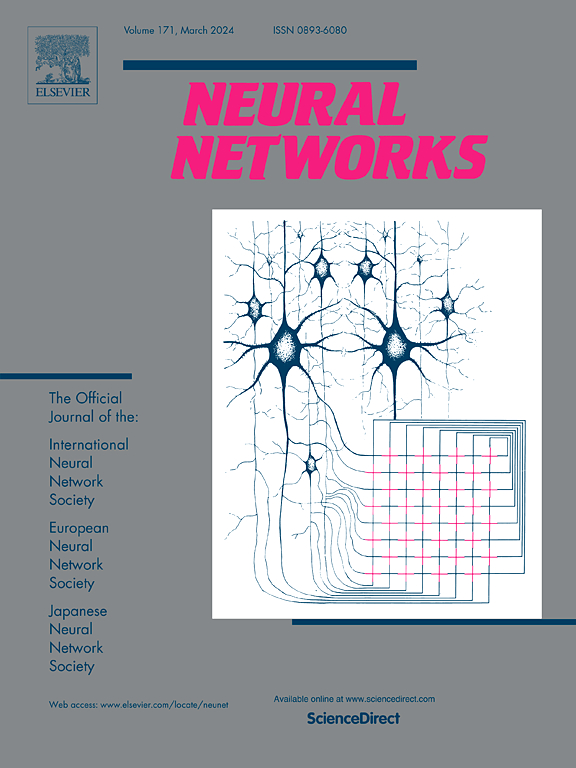由生物启发的视觉碰撞检测网络,集成了由可扩展功能性反抖动流调节的动态时差反馈。
IF 6
1区 计算机科学
Q1 COMPUTER SCIENCE, ARTIFICIAL INTELLIGENCE
引用次数: 0
摘要
在研究人工智能如何帮助机器人高效避免碰撞的过程中,研究人员从蝗虫的视觉隐现敏感神经回路中汲取灵感,建立了一种高效的碰撞检测神经网络。然而,现有的生物启发碰撞检测神经网络遇到了抖动流带来的挑战,例如,当地面机器人在不平坦的地形上移动时,通常会遇到抖动流现象。来自抖动流的视觉输入会引起灰度值的显著波动,从而干扰现有的生物启发网络提取视觉隐约特征。为了克服这一局限,我们从反馈回路的潜力中获得灵感,使大脑产生连贯的视觉感知。我们在传统的生物启发碰撞检测神经网络中引入了由可扩展功能调节的新型动态时差反馈回路。这种反馈机制从传统网络中高阶神经元的输出中提取动态时间方差信息,以评估局部神经反应的波动水平,并通过可扩展函数对其进行调节,以区分不连贯视觉输入引起的方差。然后,调节后的信号通过负反馈回路重新整合到输入中,以减少网络内信号的不连贯。数值实验证实了所提出的反馈回路在促进碰撞检测以对抗抖动流方面的有效性。这项研究扩展了生物启发碰撞检测神经网络的能力,以应对抖动流的挑战,为反馈机制在增强视觉神经能力方面的潜力提供了新的见解。本文章由计算机程序翻译,如有差异,请以英文原文为准。
A bio-inspired visual collision detection network integrated with dynamic temporal variance feedback regulated by scalable functional countering jitter streaming
In pursuing artificial intelligence for efficient collision avoidance in robots, researchers draw inspiration from the locust’s visual looming-sensitive neural circuit to establish an efficient neural network for collision detection. However, existing bio-inspired collision detection neural networks encounter challenges posed by jitter streaming, a phenomenon commonly experienced, for example, when a ground robot moves across uneven terrain. Visual inputs from jitter streaming induce significant fluctuations in grey values, distracting existing bio-inspired networks from extracting visually looming features. To overcome this limitation, we derive inspiration from the potential of feedback loops to enable the brain to generate a coherent visual perception. We introduce a novel dynamic temporal variance feedback loop regulated by scalable functional into the traditional bio-inspired collision detection neural network. This feedback mechanism extracts dynamic temporal variance information from the output of higher-order neurons in the conventional network to assess the fluctuation level of local neural responses and regulate it by a scalable functional to differentiate variance induced by incoherent visual input. Then the regulated signal is reintegrated into the input through negative feedback loop to reduce the incoherence of the signal within the network. Numerical experiments substantiate the effectiveness of the proposed feedback loop in promoting collision detection against jitter streaming. This study extends the capabilities of bio-inspired collision detection neural networks to address jitter streaming challenges, offering a novel insight into the potential of feedback mechanisms in enhancing visual neural abilities.
求助全文
通过发布文献求助,成功后即可免费获取论文全文。
去求助
来源期刊

Neural Networks
工程技术-计算机:人工智能
CiteScore
13.90
自引率
7.70%
发文量
425
审稿时长
67 days
期刊介绍:
Neural Networks is a platform that aims to foster an international community of scholars and practitioners interested in neural networks, deep learning, and other approaches to artificial intelligence and machine learning. Our journal invites submissions covering various aspects of neural networks research, from computational neuroscience and cognitive modeling to mathematical analyses and engineering applications. By providing a forum for interdisciplinary discussions between biology and technology, we aim to encourage the development of biologically-inspired artificial intelligence.
 求助内容:
求助内容: 应助结果提醒方式:
应助结果提醒方式:


